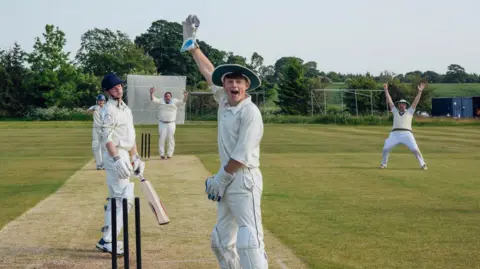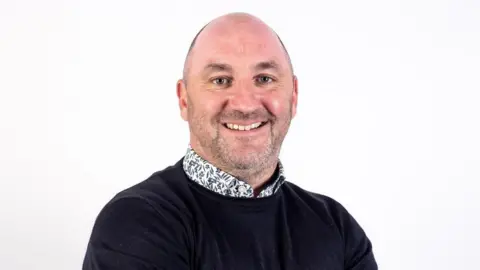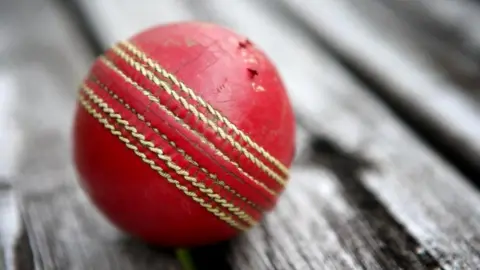The teachers fighting to save cricket in schools
 Getty Images
Getty ImagesTraditional cricket is declining in state schools, according to a report from York St John University. We speak to teachers and experts about keeping the sport alive - and why cricket still matters in Yorkshire.
A game once played as much between rows of back-to-back terraces as in private schools, cricket is increasingly a sport of the elite.
That's according to a report by Dr Andrew Scattergood, who says the hardball game is becoming out of reach for many working-class children.
The "significant decline" is a result of lack of facilities and equipment, low teacher confidence in delivering and developing the game, and limited access to structured fixtures or links to local clubs, he says.
Dr Scattergood says working-class boys and girls are not talking about cricket the way they did 20-30 years ago.
"An overall awareness of the game of cricket within working-class communities seems to have drifted away," he says.
"Without getting too sentimental, there was a generation of people who grew up falling over cricket, watching test matches on the BBC. The minute it went on to pay-per-view TV, a lot of people didn't see it.
"And we are inundated with football. It's ubiquitous. Cricket seems to have slipped away from the mindset of a lot of working-class communities as a sport that working-class people play."
'Real discrepancy'
Dr Scattergood says although the game remains popular at primary school level, once children move beyond playing with a soft ball and on to the hard leather cork ball, playing drops off.
"It's not surprising that more and more middle-class pupils are representing county pathways and going on to dominate the elite game," he says.
"If you've got 11 and 12-year-old lads in Rotherham, for example, playing with a softer ball and not really being taught about hardball.
"You think of the equivalent of somebody at private school that age who has access to nets, cricket fixtures, grass, wickets, equipment, elite coaches...
"It's not surprising why we've seen this real discrepancy at the top end, this over representation of privately educated pupils in county pathways.
"And in the elite game, it can only get worse unless something's done about it."
In the study, researchers asked 427 state secondary schools to complete a survey.
It asked teachers about how many PE curriculum hours were allocated to cricket, the availability of facilities, extra-curricular participation, the number of interschool fixtures and the amount of cricket-related trips.
After this, Dr Scattergood conducted interviews with 18 male PE teachers.
 York St John University
York St John UniversityAndrew Raw teaches PE at Whitby School, where Yorkshire batsman Adam Lyth studied. He played alongside Lyth's brother Ashely as child.
The school has a cricket team in every year group - but this is largely because of the healthy village scene locally, says Mr Raw.
"We're quite lucky we've lots of local clubs in our area. These are the teams that boys and girls play for on a night time and then that interest continues into school.
"We've ended up with quite a bit of interest in cricket over the last few years, possibly not as much as 20/15 years ago, but it's still healthy and thriving in our area."
The school plays teams in the district cups, and this summer it will have four year group clubs in four district finals.
"In the area, it's the support of the people and the village communities," he says.
"If the children are invited to the clubs then that interest stays and we're lucky at school that we see that.
"But cricket isn't as strong as it was. The younger generation will play but they don't want to commit to a full Saturday, they want to play Twenty20. They prefer a shorter format."
The school teams play hard ball from aged 11, but in lessons they play lighter wind balls to encourage a transition.
"You have to make sure they feel comfortable batting and catching with a hard ball," he says.
"It's down to the coaches, and making sure you know your team and what's comfortable."
Mr Raw is still friendly with Lyth who regularly comes back to the school and Whitby Cricket Club to support youngsters.
"If you look at the current crop of players coming through, many come from the private system," says Mr Raw.
"It's often those children who make it through to the professional level because they have more coaching time and better facilities.
"Whereas we're trying to do six lessons of cricket over a summer term of six weeks to hopefully encourage them to take up cricket outside of school.
"Eventually we want another Adam Lyth. It would be perfect to see a professional cricketer come through the school."
 PA Media
PA MediaGavin O'Loughlin is head of PE at Bishop Young Academy in Seacroft, Leeds.
The school has a predominantly working-class intake, with an increasing number of students from diverse backgrounds.
He took part in the York study, and believes teachers need more training to improve their confidence with a hard ball.
"In the whole school we probably only have one or two who play outside of school. So you can imagine the barriers we face," he says.
"For staff who are not competent enough, continuing professional development (CPD) from national governing bodies would be great.
"We need a school CPD package for staff to give them more confidence to deliver the hard ball game and deliver a platform or competition that's suited for schools like ours."
The school has one cricket team, which plays with a hard ball, but uses a wind ball or tennis ball during PE lessons.
"When I ask them to play with a hard ball, it's a different concept completely," he says.
"If we play against proficient schools with teams of students who play outside of school it would be difficult for us to compete, because going to any sporting event and getting beat heavily is going to be demoralising."
Despite the lack of training and resources, Mr O'Loughlin says taking children to cricket matches at nearby Headingley Stadium is much better value for money than football or rugby games.
"We took a group of children to a T20 Blast last Friday. Some of our pupils had never set foot in a live sporting arena, let alone a cricket match, so as you can imagine they were a little bit overwhelmed.
"And that's only going to drive their passion to engage with cricket in the future."
Listen to highlights from North Yorkshire on BBC Sounds, catch up with the latest episode of Look North.
